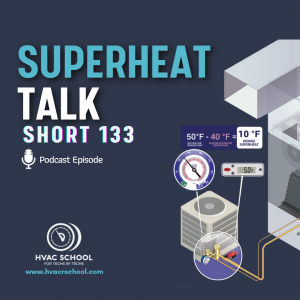Superheat Talk – Short 133

In this short podcast, Bryan goes over the basics of superheat and explains why it matters to us.
Superheat is the temperature increase above a substance’s saturation temperature or boiling point. When a substance is superheated, that means it is 100% vapor; there is no liquid at all. We can look at our superheat to determine how much refrigerant is feeding our evaporator coil.
A lower superheat indicates that our evaporator is more full of refrigerant than a high superheat, meaning that the refrigerant is feeding the evaporator coil well. Generally, a lower superheat value will be more efficient, but if the superheat gets too low, we can get liquid in the suction line and compressor.
An evaporator can maintain roughly the same temperature throughout the bulk of the coil because the temperature stays the same during a phase change. As the refrigerant boils off from its liquid state, it remains at the boiling point. You generally want to see no less than 6 degrees of superheat, especially at the compressor. Zero superheat indicates that you have some liquid refrigerant (or that the system is off).
Superheat can get tricky when we use refrigerant blends with glide. The different refrigerants in a blend have different boiling points, so the evaporator temperature can drift up. When determining the superheat of blends, we use the dew point to calculate the superheat (and bubble point for subcooling).
We get superheat in the evaporator (suction line at the evaporator outlet) and the compressor (suction line at the compressor inlet). The latter will be higher because some sensible heat will be absorbed in the suction line.
If you have an iPhone, subscribe to the podcast HERE, and if you have an Android phone, subscribe HERE.
Check out our handy calculators HERE.
Check out information on the 2022 HVACR Training Symposium at https://hvacrschool.com/symposium/.
Author:









Comments
Love your classes!
Love your classes!
Love the talk. Could you done one on sub-cooling please
Love the talk. Could you done one on sub-cooling please
To leave a comment, you need to log in.
Log In